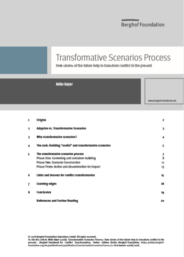
Transformative Scenarios Process: How stories of the future help to transform conflict in the present

Scenarios are stories of possible futures. Human beings have always used stories to talk about things that are difficult, complex, or even taboo, to encourage a change in thinking, illuminate pathways, and inspire right action. Creating and telling stories about possible futures allows us to lift our gaze above our current stuck situations and polarized conversations into a longer time horizon and ask ourselves “what if?”
Scenario methods are gaining popularity as a way of engaging with accelerating complexity and uncertainty, and involving diverse stakeholders in a dialogue about the future. Various approaches to scenarios exist, commonly grouped under the label of “foresight methods”, making up an increasingly lively field.1 The fact that scenario thinking is about entertaining multiple possibilities is reflected also in a diversity of scenario approaches. Scenario practitioners and academics alike tend to recognize that different methods are shaped to fit different tasks and become valid in different circumstances.
This article is written from the perspective of a reflective practitioner with the intention to explore in particular the approach called “Transformative Scenarios Process” (TSP), developed by Adam Kahane, and its relevance to the field of conflict transformation. I first encountered Kahane and his work in 1999, and subsequently started working with him in 2004. Since then, I have worked as an organizer and facilitator of multi-stakeholder processes at international, national and local levels, in many cases applying a TSP approach.
TSP has not previously been directly considered as a method of the fields of peacebuilding and conflict transformation. It is applied in some contexts where direct violence is present, but more frequently in domains such as education, food security or healthcare, where social systems are polarized and stuck due to non-violent clashes of ideas and interests. As the international peacebuilding field expands to include conflict prevention and sustaining peace, and as TSP increasingly demonstrates its relevance to peace processes and situations affected by violent conflict, these two conversations are starting to connect more closely. As this happens, it is worth noting a shared underlying paradigm that emphasizes systemic change, inclusion, root causes, and drivers of change, as well as a shared acknowledgment of the transformative potential of conflict
- Issue:
- Global and Domestic Governance
- Region:
- Global
- Year Published:
- 2018
- Author:
- Mille Bøjer
- Institution:
- Berghof Foundation

